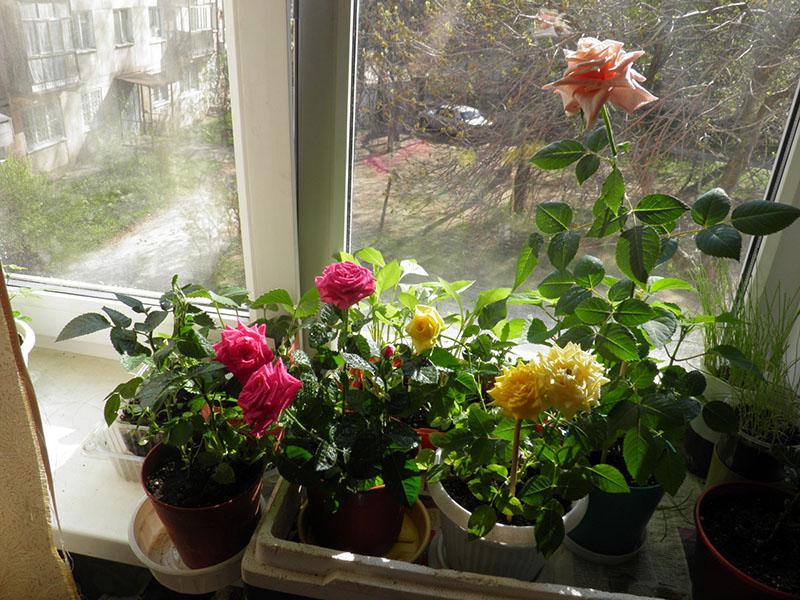Tea rose in a pot: features of care, transplantation and reproduction
 Inexperienced growers believe that a tea rose in a pot requires difficult maintenance and is difficult to achieve long-term flowering from it. This is not entirely true. The plant is capricious, often attacked by pests and diseases. But knowing a few key rules of care, you will be able to cope with all the problems. With a little effort, you can decorate your home with a gorgeous rose with a subtle refined scent.
Inexperienced growers believe that a tea rose in a pot requires difficult maintenance and is difficult to achieve long-term flowering from it. This is not entirely true. The plant is capricious, often attacked by pests and diseases. But knowing a few key rules of care, you will be able to cope with all the problems. With a little effort, you can decorate your home with a gorgeous rose with a subtle refined scent.
What does a potted tea rose look like and why is it called that?

A distinctive feature is that after the flower is fully opened, the yellow center becomes visible. And the dark green leaves, located on thin, but very strong stems, become a spectacular frame of such beauty.
China is recognized as the homeland of this flower. There are several versions of why the rose was named exactly as a tea house. According to one of them, the flower resembled a bowl from which it is customary to drink tea in the land of the rising sun. According to the other, the aroma of the flower seemed so delicate and delicate to the discoverers that it reminded them of the most exquisite varieties of Chinese tea.
The tea rose is not just an ornamental plant. At all times, it has been used as a medicine for many diseases. Petal tea will help to calm down, improve immunity and mood.
Optimal growing conditions

In order for a tea rose to please with its growth and flowering, it needs to create comfortable conditions:
- The air temperature in spring and autumn should remain in the range from +20 to +25 degrees Celsius. For the winter, the plant is transferred to a cool room, where the temperature is maintained from +10 to +17 degrees.
- Rose grows well only in conditions of air humidity of at least 75%. Otherwise, it is often damaged by spider mites and various diseases. Dry hot air is recognized as the most dangerous for a plant. Even short-term exposure can lead to the death of the flower.
- For the leaves to have a rich green color, and the flowering is lush, the plant needs enough light. It is placed on a window facing east or southeast. In the daytime, the rose is often shaded with tulle to avoid burns on the leaves.
For a tea rose in a pot, drafts, sudden changes in temperature, and the scorching rays of the sun are destructive. Do not place the plant near an air conditioner and heating devices.
Purchase and transfer
 It is better to purchase a plant in proven garden centers. This way you can be sure that the flower is not infected with dangerous pests. When choosing, they pay attention to the condition of the plant itself, and not to the number of buds. Often, the bush is forced to bloom vigorously with special preparations. After transplanting, such roses often die.
It is better to purchase a plant in proven garden centers. This way you can be sure that the flower is not infected with dangerous pests. When choosing, they pay attention to the condition of the plant itself, and not to the number of buds. Often, the bush is forced to bloom vigorously with special preparations. After transplanting, such roses often die.
You should only buy a healthy plant with dark green foliage. It should not show signs of disease and parasite damage. If the bush looks lethargic and lifeless, it is better to refuse the purchase.
An important question is how to transplant a purchased rose into a pot.You cannot do this immediately after returning from the store. The plant must acclimate. One to two weeks is enough for this.
 Before transplanting, the plant is treated with any pest repellent. The pot is chosen so that it is a couple of centimeters larger than the container in which the plant was purchased. It is better to take the substratum purchased, designed specifically for roses.
Before transplanting, the plant is treated with any pest repellent. The pot is chosen so that it is a couple of centimeters larger than the container in which the plant was purchased. It is better to take the substratum purchased, designed specifically for roses.
You can also make up the soil yourself. To do this, mix 2 parts of sod, 1 part of leafy ground, 1 part of humus. Add some sand. The transplant is carried out by the transfer method.
After transplanting from the plant, it is recommended to cut off all flowers and buds. This will make it easier for the rose to survive stress, and it will begin to build up the root system.
Care rules

Novice flower growers often have a question about how to care for a tea rose. It is not difficult, it is enough to adhere to the following recommendations:
- Water the plant as the topsoil dries out. In the winter months, watering is reduced to 1 time per week. You can only use warm, settled water.
- Every 30 days, the plant is given a shower with warm water. Before the procedure, the soil is covered with a film to avoid waterlogging.
- Top dressing is applied in spring, summer and autumn. For this, you can use ready-made fertilizers. Potted tea rose responds well to fertilizing chicken droppings... To do this, it is diluted in water in a ratio of 1 to 2, insisted for a week. The finished fertilizer is diluted in water in a ratio of 1 to 15 and the plant is watered.
- The plant is pruned twice a year. In the spring, remove all branches directed to the center of the bush. In autumn, the stems are cut so that no more than 5 buds remain on them. During the entire life of the plant, damaged branches, yellowed leaves and wilted flowers are regularly removed from it.

Caring for a room tea rose at home also includes protection from diseases and pests. More often, the plant suffers from spider mites, aphids, powdery mildew or rust. At the first sign of a problem, specialized drugs are used.
Potted tea rose and transplant rules
 Mature plants need replanting every year. If a rose is grown from a cutting, then in the first year it will have to change its pot two or three times. Too tight pots will stop the development of the root system.
Mature plants need replanting every year. If a rose is grown from a cutting, then in the first year it will have to change its pot two or three times. Too tight pots will stop the development of the root system.
The best way to plant a tea rose in a new pot at home is the transfer method. It is the least traumatic for the plant. The day before the start of the procedure, the plant is watered abundantly.
The transplant is divided into several stages:
- The bush is carefully removed from the pot along with a lump of earth.
- Examine the roots. If there are signs of decay, then the damaged roots are cut off. The cut site is powdered with ash or crushed activated carbon.
- The top 2 cm of the earth is removed from the coma.
- Drainage and some fresh soil are poured into a new pot.
- Place the bush in a pot.
- Pour in fresh soil until the container is full. Slightly compact the top layer.
 After transplanting, the plant is watered abundantly. It is also recommended to spray it over the leaves with any anti-stress drug, for example, Epin.
After transplanting, the plant is watered abundantly. It is also recommended to spray it over the leaves with any anti-stress drug, for example, Epin.
Before starting the transplant, you need to disinfect both the pot and the ground. To do this, wash the planter well with a solution of potassium permanganate. The earth can be kept in the oven for several minutes or spilled with boiling water.
Reproduction
 The best way to propagate tea roses is by cuttings. To obtain planting material, shoots are cut from the bush, leaving at least three buds on them. The resulting stalk is placed in a container with a solution of a rooting stimulator. After a couple of weeks, the first roots will appear.
The best way to propagate tea roses is by cuttings. To obtain planting material, shoots are cut from the bush, leaving at least three buds on them. The resulting stalk is placed in a container with a solution of a rooting stimulator. After a couple of weeks, the first roots will appear.
After the cutting is planted in a small pot filled with nutritious soil. From above it is covered with plastic wrap. As the plant grows, it will need to be transplanted into a larger pot. Blossoming from such a rose can be expected already in the second year after rooting.
What to do when a rose doesn't bloom

The most common question for novice growers is why a tea rose does not bloom. There are several answers to it:
- Not enough light. If the windows face the non-sunny side, you will have to arrange additional lighting for the plant. For this, it is recommended to use special phytolamps.
- Inappropriate indoor climate. Roses stop blooming in rooms with low humidity. Installing a humidifier will help solve the problem. If it is not possible to purchase a device, open containers of water are placed next to the plant. Spraying the bush with warm water regularly will also help.
- Lack of nutrition. If the leaves have lost their rich shade, yellowish spots have appeared between the veins, probably the rose is gnawing. In such a situation, she simply does not have enough nutrients for flowering. You need to feed her with complex fertilizer.
- Excess food. In an attempt to achieve lush flowering, inexperienced growers apply too much fertilizer to the soil. As a result, the soil becomes salted. The root system cannot fully extract useful substances from it. Transplanting into fresh soil and establishing a normal feeding regime will help to solve this problem.
The frequency of flowering of a tea rose also depends on the specific variety. Some of them are able to delight with luxurious flowers almost all year round. But basically a store-bought plant will bloom twice a year.